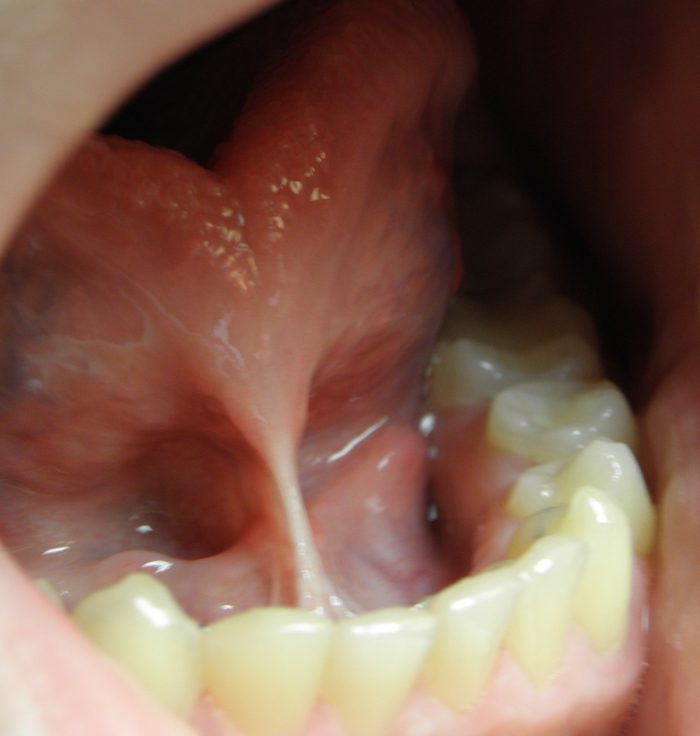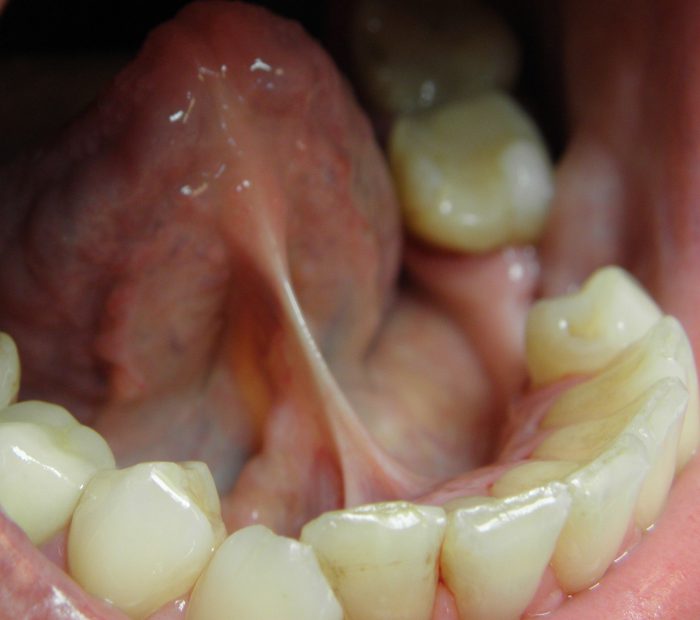Frenulum treatments
Dentysta stomatolog Warszawa Ursynów ADENTIS / Services / Surgery with implantology / Frenulum treatments
| The frenulum of the lips and tongue are bands of tissue connecting the lip or tongue to the alveolar ridge, with which abnormalities such as frenulum located too close to the teeth, too short or thick are not uncommon, having a detrimental effect on the periodontium, aesthetics of the dentition, alignment of the teeth or maintenance of removable dentures. A short sublingual frenulum is a common anatomical change in the structure of the oral cavity. It occurs with a frequency of about 1:2,000 births and happens to run in families. |  |
An oversized frenulum of the tongue:
- It promotes the development of periodontal disease, bone atrophy and tartar deposition.
- It also affects the atrophy of the bone plate of the lower incisors from the tongue, and can shift the teeth causing displacement or leaning.
- A child with a shortened frenulum has numerous speech defects, the most common disorders include interdental seplination of the three rows, where the tongue slides between the teeth during articulation. Improper frenulum length restricts the movements of the tongue, which consequently leads to the fixation of an abnormal swallowing pattern and causes numerous speech defects.
 |
 |
An oversized frenulum of the tongue led to:
- Atrophy of the alveolar bone plate on the side of the tongue in the area of the lower incisal teeth – periodontal disease of the incisal teeth (periodontitis)
- excessive calcification
- inflammation of the gums (swelling and bleeding of the gums)
- abrasions of the incisal surface of anterior teeth
- tooth displacement
- incisal teeth leaning
- clash of incisors
Pull syndrome
Pull syndrome – pulling the frenum through the lip causes bone atrophy and exposed tooth necks
It leads to the formation of diastema – a break. Between the upper ones. Correction of the above abnormalities is the subject of frenulum treatments. This is a simple procedure, performed under local anesthesia, to undercut a too-short frenulum that reduces the mobility of the tongue or lips. Overgrown upper lip frenulum
The frenulum of the upper lip is a vertical fold of mucosa in the shape of a triangle, running in the midline from the inner surface of the lip to the outer surface of the alveolar process of the jaw. It divides the upper vestibule of the mouth into a right and left part.
Carlo de Giorgi cold electrosurgical knife (diathermy)
With the electrosurgical knife, frenulum cuts can be made without pressure. The tip of the instrument easily penetrates the tissue, enabling a precise, nearly bleeding-free cut with constant control of the operated area. With this device, there is an extremely short healing time and a minimization of scar tissue formation in the patient.
The main goal of procedures in modern electrosurgery is to achieve clean cutting or coagulation with minimal generation of side heat, as it is responsible for adverse effects.
In periodontics and surgery, diathermy is most often used for central and lateral frenectomy, gingivectomy and gingivoplasty. Gingival overgrowth can be caused by ecotopic or incomplete eruption of teeth, orthodontic treatment, pharmacotherapy, poor oral hygiene. The use of electrosurgery in the aesthetic correction of the so-called “cosmetic”. gummy smile.
True diastema in a child
The low position of the attachment of the upper lip frenulum observed in deciduous teeth can spontaneously increase after the replacement of incisors. Often the closure of the diastema then follows as well. The persistence of a low frenum attachment in mixed dentition after all incisors have erupted is referred to by the term persistent upper lip frenum.
Developmental defects of the upper lip frenulum in the form of hypertrophy and abnormally localized attachments can pose orthodontic, periodontal, speech therapy, prosthetic and aesthetic problems.
Overgrown, low-attachment lip frenum requires surgical treatment for orthodontic, speech therapy, periodontal, prosthetic and aesthetic indications.
- Low attachment of the upper lip frenulum is the cause of true diastema in deciduous or permanent teeth . Low and hypertrophied upper lip frenum in deciduous teeth should be observed. The wide, fan-shaped frenulum is sometimes subject to injury and inflammation. This is due to their mechanical damage during the work of the circular muscles of the mouth and the lodging of food debris in the folds of the frenulum.
- Accompanying decay on the medial surfaces of the central incisors can lead to chronic inflammation and papillary overgrowth . In such exceptional, complicated cases, surgical intervention is already indicated in the deciduous dentition. In other situations, early treatments should be avoided. Diastema less than 2 mm wide generally closes spontaneously after eruption of permanent incisors and canines. Wider may be an indication for surgical correction of the lip frenulum.
- Low attachment of the upper lip frenulum in deciduous teeth as a cause of diastema, caries on the medial surfaces of incisors and chronic interdental papillitis.
- Periodontal problems are associated with the formation of atrophic changes in the periodontium of the medial incisors, which manifests itself as gingival recession. A clinical harbinger of future periodontal changes is the pull symptom (pull syndrome) – when pulling the upper lip forward and upward, an anemization of the mucosa of the attached and free gingiva is observed . This symptom is an indication for prophylactic frenectomy to avoid later periodontal complications.
- In addition, the correction of the frenulum attachment facilitates the maintenance of proper hygiene of this area of the oral cavity .
- Pull symptom (pull syndrome) – anemization of the mucosa of the attached gingiva.
- The low attachment of a hypertrophied upper lip frenulum can cause impaired pronunciation of front-language sounds.
- Abnormal attachment and hypertrophy of the upper lip frenulum is often the cause of poorer retention of the upper denture, due to pushing it down. The surgical procedure in such patients significantly improves the conditions of the prosthetic field.
- A low, hypertrophied upper lip frenum in conjunction with a diastema is perceived by patients as an aesthetic defect. This is especially true for those with a gingival type of smile (gummy smile, gingival smile), when more than 2 mm of marginal gingiva is visible during a wide smile, with a strongly emphasized frenulum.
